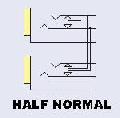For those of you interested in the progress . .
The concept model worked. I was able to adjust the contrast of the display at the straight-on viewing angle from weak and barely readable to nearly totally blacked out. The weak display got clearer as I looked down on it from above, which is what I was after, but at its best, it was only marginally better than the fixed setting that Mackie chose for it. Although I didn't take it out in the sunlight, it was clear that there wasn't going to be an improvement worth the effort to implement a non-haywire version.
It's interesting how the contrast control is implemented. The display module contains a DC-DC converter that takes 5V at the input, and shoots -5V out one pin of the connector. Another pin takes a variable input voltage around -3.5V, and that's what sets the display contrast. In the HDR, the -5V goes through a ribbon cable to a regulator circuit on the Brain board, then comes back through the ribbon cable to the contrast control pin. Two resistors determine the output voltage of the regulator.
The LCD data sheet shows a simpler implementation, a 5KΩ pot connected between the -5V and ground pins, with the wiper connected to the contrast control input. Rather than butcher the Brain board before I knew how effective a contrast control would be, I decided to try a simpler approach to test the concept.
I made a substitute for the original ribbon cable by cutting the connectors of a standard IDE hard drive cable so it would fit the 16-pin headers. I used a hard drive cable for two reasons - I had plenty to spare (doesn't everyone who has an HDR and bought some disk drives in retail packaging?), and it has a connector in the middle that I could use for measuring and monitoring voltages. Modern circuit boards with surface mounted components like this one don't have many places that can be used as test points, I wanted to verify voltages on the power pins first since some of the signal names were different on the Mackie schematic than on the LCD data sheet.
So connected the LCD to the Brain board with my hacked cable, confirmed the wires that carried voltage to and from the regulator for the contrast-setting pin, and measured the voltage at the contrast control input for reference.
Then, I separated those three wires from the ribbon bundle, cut them to disconnect the regulator on the Brain board from the display module, and soldered a pot to the three leads on the LCD end of the cable. I fired up the recorder, turned the pot so I could see something (pleased that this kludge worked at all), and then adjusted it as I stood above and stooped below the recorder. That's when I concluded that there really wasn't any point in finalizing the modification since it still wasn't easily readable from my standing position. So I put it back together.
In the end, I guess AGN or whoever Roland is this week was right - adding a display contrast control wouldn't be worth the effort. But surely he didn't actually know that, and now I do. And now so do you.
Since I really don't want to build up a temporary stack of gear any higher than necessary, maybe the next project will be a viewing hood that's a better sun shield than a piece of folded up and taped on festival program booklet.
hDR Display Contrast Control
1 post
• Page 1 of 1
hDR Display Contrast Control
--
Understanding storage technology is not difficult. It is an ongoing process whereby larger and larger amounts of information can be lost by smaller and smaller mishaps.
Understanding storage technology is not difficult. It is an ongoing process whereby larger and larger amounts of information can be lost by smaller and smaller mishaps.
-

Mike Rivers - Premium Member

- Posts: 77
- Joined: Sat Nov 22, 2008 10:31 pm
1 post
• Page 1 of 1
Return to HDR/MDR/SDR recorders
Who is online
Users browsing this forum: No registered users and 19 guests